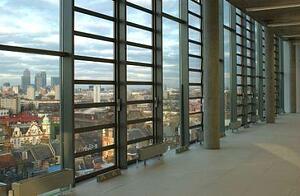 Following our recent article on the “Top three considerations when specifying glass louvred ventilators” we have been inundated with questions about modulating controls. Clearly this is a topic that resonates with many in the industry, and in this article we aim to provide some guidance on how to modulate louvred window ventilators.
Following our recent article on the “Top three considerations when specifying glass louvred ventilators” we have been inundated with questions about modulating controls. Clearly this is a topic that resonates with many in the industry, and in this article we aim to provide some guidance on how to modulate louvred window ventilators.
As we wrote in our previous article, when it comes to controls, the devil is in the detail. Let’s begin by looking at the different types of actuators you can choose from:
1. Standard 24v or 230v Actuator
This type of actuator is more suited for systems where modulation is not required, as it is very difficult to provide full modulation with it. Stepped control, opening the blades in 4 stages, is possible via a local control module. This control module will require the following components:
- Transformer to reduce voltage supply from 230v to 24v.(if using a 24v actuator)
- Relay switch to enable power to open/close.
- Time delay card to restrict power thus providing stepped control.
- 0-10v BMS signal.
2. Semi Intelligent 24v Actuator
These actuators can provide full modulation via a local control module. This control module will require the following components:
- Transformer to reduce voltage supply from 230v to 24v.
- Relay switch to enable power to open/close.
- Servo card to modulate the louvred window blades.
- 0-10v BMS signal.
The first actuator of each zone must be fitted with a special master actuator, all other actuators then act as slaves and mimic the master’s position.
3. Fully Intelligent 24v Actuator
These can be linked directly to the BMS without the requirement of a control module, but a local power unit will be required to transform voltage supply from 230v to 24v.
Key considerations when specifying modulating controls:
- All actuators require a 0-10V BMS signal to modulate.
- The BMS will only provide a data signal; a power supply will also be required.
- The power supply will need to be reduced from 230v to 24v.
- A relay switch will be required to change between power open/close.
- If the glass louvred vents are being used for smoke control then operation must be through a properly designed and certified smoke control system. A BMS link can usually be fed through this smoke control system for operation in day-to-day mode.
Finally, as we said in our previous article, don’t feel shy about getting advice:
- Discuss with your supplier how best to control your system in more detail before specifying your glass louvred ventilators and the modulating controls.
- Or you can speak to a Colt specialist : Contact Colt and read about our Coltlite glass louvred ventilator
 Graeme Clark is a Senior Consultant for Colt UK and specialises in the design and product application of energy efficient HVAC and smoke control systems.
Graeme Clark is a Senior Consultant for Colt UK and specialises in the design and product application of energy efficient HVAC and smoke control systems.


